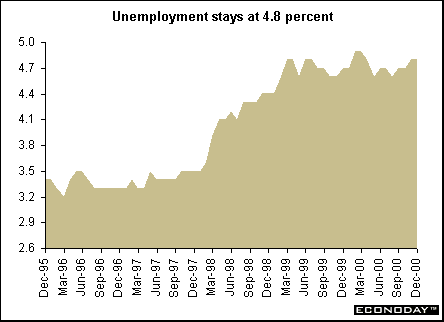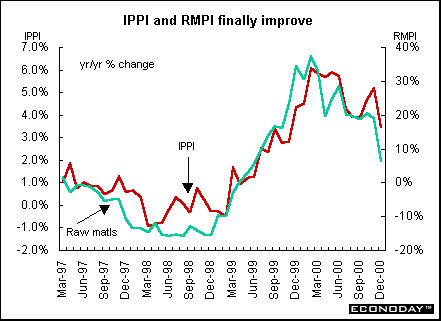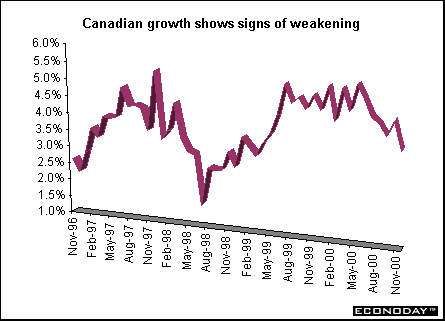
Indicator scoreboard
EMU - December seasonally adjusted unemployment rate remained at 8.7 percent, more than double that of the United States (4.2 percent). The unemployment rate was 9.6 in December 1999.

Third quarter gross domestic product was revised down to an increase of 0.6 percent and 3.3 percent on the year. The increase was due mainly to stronger gross fixed capital formation and a rise in inventories. Consumers spent less than in the previous quarter while the trade balance subtracted from GDP.
January seasonally adjusted Reuters purchasing managers' index fell to 52.9. The index, which dropped for the ninth month in a row and hit its lowest level since June 1999, indicated that the pace of manufacturing sector growth continues to slow. At the same time, however, the PMI input price index fell again, even though it remained at a high level. An index level above 50 indicates the manufacturing sector is expanding, while a level below 50 indicates contraction. The higher the index above 50, the stronger sector growth. The EMU PMI is based on results from Germany, France, Italy, Spain, Ireland, Austria and Greece.

January European Commission confidence among executives and consumers fell to 103 from 103.3 in December, the lowest level since October 1999. The index of consumer confidence fell to minus 2 from minus 1, while a business confidence measure declined to 2 from 5. The report covers retailing, manufacturing, and construction, as well as consumer confidence. The index now includes Greece, which became an EMU member on January 1,2001.

France - December producer price index dropped 0.8 percent but rose 4.7 percent when compared with last year. Excluding food and energy, the producer price index rose 0.1 percent and 2.6 percent year on year. December energy prices plunged 5.7 percent on the month but jumped 13.6 percent on the year.
December seasonally adjusted unemployment rate remained at 9.2 percent, according to the International Labor Organization definition, which excludes job seekers who did any work during the month. Compared to December 1999 when the ILO rate was 10.6 percent, unemployment was down 13.4 percent.

Italy - December non-EU trade surplus shrank to L1.714 trillion, compared with L2.725 trillion in December 1999. Non-EU imports were up 14.1 percent while exports rose 23.8 percent when compared with last year. The worsening of the trade balance seen throughout the year was caused by higher oil prices. November trade deficit with EU trading partners was L1.382 trillion. EU exports rose 12.8 percent while imports rose 17.4 percent from November 1999.
December producer prices edged down 0.1 percent but rose 6.2 percent when compared with last year. Intermediate goods shed 0.4 percent on the month but were up 9.7 percent when compared with last year. Consumer goods rose 0.3 percent on the month and 2.1 percent on the year, while investment goods were unchanged on the month and up 1.2 percent on the year. Excluding energy, the PPI rose 0.1 percent on the month and 2.8 percent on the year.
Spain - December non-seasonally adjusted producer prices declined 0.2 percent due mainly to lower energy prices. When compared with December 1999, Spanish producer prices rose 5.0 percent. Energy product prices fell 3.1 percent. Producer prices for intermediate goods - the category in which energy prices are listed and which accounts for almost half (47 percent) of the weighting in the producer price index - fell 0.6 percent on the month but rose 8.7 percent on the year.
Britain - January seasonally adjusted Nationwide house prices rose 2.5 percent and 11.2 percent when compared with last year. In December, they rose 1.2 percent and 9.3 percent on the year. The latest rise was attributed to relatively buoyant consumer confidence.

Asia
Japan - December seasonally adjusted industrial production rose 1.5 percent after declining 0.8 percent a month earlier. Production rose 0.3 percent in the three months ended December 31 when compared with the previous quarter. Transport equipment production rose 4.8 percent last month. General machinery output increased 2.3 percent, led by chip making equipment. December total shipments of manufactured goods rose 1.7 percent and 3.7 percent from a year ago.
December seasonally adjusted consumer confidence was little changed from September, as people said they were worried about their wages and jobs. The confidence index rose 0.1 point to 43.4, the smallest increase since it began rising in September 1999. The increase was the sixth in a row, but income and employment worries capped the gain.
December unemployment remained at a nine month high of 4.8 percent as construction and manufacturing companies continued to cut employment. The economy shed 230,000 jobs last month while 210,000 people left the workforce, leaving the unemployment rate unchanged at just below the record 4.9 percent reached in March. Last year, the jobless rate averaged 4.7 percent, the same as in 1999, which was the highest in 46 years. Job seekers cannot find jobs while corporate bankruptcies and restructuring are also helping to keep the rate up high.

December seasonally adjusted spending by households headed by a salaried worker rose 0.5 percent, the first increase in three months. Spending rose 0.8 percent when compared with last year. Spending by salaried workers, which accounts for about 60 percent of all households, fell 0.5 percent in the three months ended December 31 from the third quarter. For all of last year spending fell 0.6 percent from 1999, the third straight annual decline.
December inflation adjusted real wages fell 0.2 percent when compared with last year after rising a revised 1.5 percent in November. Bonuses fell 1.5 percent. Winter bonuses have dropped about 3 percent a year the past two years. Regular wages including overtime pay increased 0.8 percent in December from a year earlier. Overtime payments rose 3.7 percent. Hours worked increased 0.9 percent as both regular and overtime hours rose.
Australia - December seasonally adjusted trade deficit widened to A$500 million ($274 million) from a revised A$15 million in November as the rebounding currency and lower wool, meat and cereal sales crunched export earnings.
December seasonally adjusted retail sales rose 0.8 percent, rebounding after two months of declines. They were buoyed by a pick up in consumer sentiment and price cutting to woo customers.
Americas
Canada - December industrial product price index (IPPI) fell 0.9 percent, the largest monthly decline since March 1998. When compared with last year, the IPPI rose 3.5 percent. Lower monthly energy prices contributed to the slowest annual rate of increase in industrial prices since November 1999. If the impact of petroleum and coal product prices were excluded, industrial product prices would have increased 1.9 percent instead of 3.5 percent. Prices for paper and paper products and motor vehicles also contributed to the annual increase, while falling prices for lumber had a dampening influence.

December raw material price index (RMPI) dropped 7.3 percent but rose 6.3 percent when compared with last year. This follows an annual growth rate of 19.1 percent in November, and remains well below the recent peak of 37.3 percent in February 2000. If mineral fuels were excluded, the monthly index would have advanced 1.2 percent. Mineral fuel prices were the primary force behind this gain, accompanied by the animal product, wood and vegetable product categories. Without the mineral fuels category, the Raw Materials Price Index (RMPI) would have risen only 2.7 percent.
November gross domestic product at factor cost edged up 0.1 percent and 3.7 percent when compared to last year. The November slight increase marked the 17th consecutive monthly gain, the longest uninterrupted series of gains in more than ten years. The slumping automotive sector pulled down manufacturing, where a sharp reduction in the production of motor vehicles and parts led to the factory sector's second decline in three months. Weak performances in the retailing and wholesaling industries can also partly be traced back to flagging consumer demand for automotive products, as imports and exports of these goods fell in November.



Introduction • Global Stock Market Indexes • Recap of Global Markets • Currencies • Indicator Scoreboard

The Bottom Line • Looking Ahead
© Econoday, 2000-2001. All Rights Reserved.
|